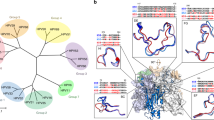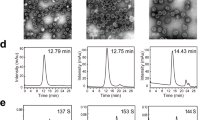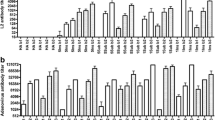Abstract
Recombinant human papillomavirus (HPV) virus-like particle (VLP) vaccines based on the L1 capsid protein have been shown to be efficient prophylactic vaccines, albeit type-specific. As a first step to investigate the feasibility of extending protection against non-vaccine types, HPV-16 L1 chimaeras were generated. The region downstream of L1 amino acid (aa) 413 was replaced with selected cross-neutralising epitopes (aa 108-120; 56-81 and 17-36) derived from the HPV-16 L2 protein, generating proteins designated SAF, L2.56 and L2.17, respectively. The chimaera L1BPV containing BPV-1 L2 peptide aa 1-88 was similarly constructed. The chimaeras were evaluated for expression in insect cells; their ability to form particles was studied by electron microscopy, and their immunogenicity was evaluated in mice. SAF, L2.56 and L2.17 proteins were expressed to high concentrations in insect cells and elicited HPV-16 pseudovirus-neutralising anti-L1 antibodies. L2.56 and L2.17 also elicited anti-L2 antibodies. L1BPV was a poor vaccine candidate due to low levels of expression with concomitant lack of immunogenicity. All chimaeras assembled into tertiary structures. The results indicate that chimaeric L1 vaccines incorporating cross-neutralising L2 peptides could be promising second-generation prophylactic HPV vaccine candidates.





Similar content being viewed by others

Explore related subjects
Discover the latest articles and news from researchers in related subjects, suggested using machine learning.References
Alphs HH, Gambhira R, Karanam B, Roberts JN, Jagu S, Schiller JT, Zeng W, Jackson DC, Roden RBS (2008) Protection against heterologous human papillomavirus challenge by a synthetic lipopeptide vaccine containing a broadly cross-neutralizing epitope of L2. Proc Natl Acad Sci USA 105:5850–5855
Bernard H-U, Burk RD, Chen Z, Van Doorslaer K, Hausen Hz, De Villiers E-M (2010) Classification of papillomaviruses (PVs) based on 189 PV types and proposal of taxonomic amendments. Virology 401:70–79
Bishop B, Dasgupta J, Chen XS (2007) Structure-based engineering of papillomavirus major capsid L1: controlling particle assembly. Virol J 4:3
Bosch FX (2009) Broad-spectrum human papillomavirus vaccines: new horizons but one step at a time. J Natl Cancer Inst 101:771–773
Bosch FX, Burchell AN, Schiffman M, Giuliano AR, De Sanjose S, Bruni L, Tortolero-Luna G, Kjaer SK, Muñoz N (2008) Epidemiology and natural history of human papillomavirus infections and type-specific implications in cervical neoplasia. Vaccine 26(Suppl 10):K1–K16
Breitburd F, Kirnbauer R, Hubbert NL, Nonnenmacher B, Trin-Dinh-Desmarquet C, Orth G, Schiller JT, Lowy DR (1995) Immunization with viruslike particles from cottontail rabbit papillomavirus (CRPV) can protect against experimental CRPV infection. J Virol 69:3959–3963
Buck CB, Cheng N, Thompson CD, Lowy DR, Steven AC, Schiller JT, Trus BL (2008) Arrangement of L2 within the papillomavirus capsid. J Virol 82:5190–5197
Buck CB, Pastrana DV, Lowy DR, Schiller JT (2005) Generation of HPV pseudovirions using transfection and their use in neutralization assays. Methods Mol Med 119:445–462
Cason J, Kambo PK, Jewers RJ, Best JM (1994) Detection of protein aggregates, but not virus-like particles, when the major (L1) coat protein of a wild-type human papillomavirus type 16 (HPV-16) is expressed in insect cells. Biochem Soc Trans 22:335S
Castellsagué X (2008) Natural history and epidemiology of HPV infection and cervical cancer. Gynecol Oncol 110:S4–S7
Chackerian B, Lowy DR, Schiller JT (1999) Induction of autoantibodies to mouse CCR5 with recombinant papillomavirus particles. Proc Natl Acad Sci USA 96:2373–2378
Chen XS, Garcea RL, Goldberg I, Casini G, Harrison SC (2000) Structure of small virus-like particles assembled from the L1 protein of human papillomavirus 16. Mol Cell 5:557–567
Christensen ND, Dillner J, Eklund C, Carter JJ, Wipf GC, Reed CA, Cladel NM, Galloway DA (1996) Surface conformational and linear epitopes on HPV-16 and HPV-18 L1 virus-like particles as defined by monoclonal antibodies. Virology 223:174–184
Christensen ND, Kreider JW (1990) Antibody-mediated neutralization in vivo of infectious papillomaviruses. J Virol 64:3151–3156
Cutts FT, Franceschi S, Goldie S, Castellsague X, De Sanjose S, Garnett G, Edmunds WJ, Claeys P, Goldenthal KL, Harper DM, Markowitz L (2007) Human papillomavirus and HPV vaccines: a review. Bull World Health Organ 85:719–726
Deschuyteneer M, Elouahabi A, Plainchamp D, Plisnier M, Soete D, Corazza Y, Lockman L, Giannini S, Deschamps M (2010) Molecular and structural characterization of the L1 virus-like particles that are used as vaccine antigens in CervarixTM, the AS04-adjuvanted HPV-16 and -18 cervical cancer vaccine. Hum Vaccin 6:407–419
de Villiers E-M, Fauquet C, Broker TR, Bernard H-U, Zur Hausen H (2004) Classification of papillomaviruses. Virology 324:17–27
Embers ME, Budgeon LR, Pickel M, Christensen ND (2002) Protective immunity to rabbit oral and cutaneous papillomaviruses by immunization with short peptides of L2, the minor capsid protein. J Virol 76:9798–9805
Fang NX, Frazer IH, Fernando GJ (2000) Differences in the post-translational modifications of human papillomavirus type 6b major capsid protein expressed from a baculovirus system compared with a vaccinia virus system. Biotechnol Appl Biochem 32(Pt 1):27–33
Gambhira R, Karanam B, Jagu S, Roberts JN, Buck CB, Bossis I, Alphs H, Culp T, Christensen ND, Roden RBS (2007) A protective and broadly cross-neutralizing epitope of human papillomavirus L2. J Virol 81:13927–13931
Huh WK, Roden RBS (2008) The future of vaccines for cervical cancer. Gynecol Oncol 109:S48–S56
Kawana K, Matsumoto K, Yoshikawa H, Taketani Y, Kawana T, Yoshiike K, Kanda T (1998) A surface immunodeterminant of human papillomavirus type 16 minor capsid protein L2. Virology 245:353–359
Kawana K, Yasugi T, Kanda T, Kino N, Oda K, Okada S, Kawana Y, Nei T, Takada T, Toyoshima S, Tsuchiya A, Kondo K, Yoshikawa H, Tsutsumi O, Taketani Y (2003) Safety and immunogenicity of a peptide containing the cross-neutralization epitope of HPV16 L2 administered nasally in healthy volunteers. Vaccine 21:4256–4260
Kawana K, Yoshikawa H, Taketani Y, Yoshiike K, Kanda T (1999) Common neutralization epitope in minor capsid protein L2 of human papillomavirus types 16 and 6. J Virol 73:6188–6190
Kirnbauer R, Booy F, Cheng N, Lowy DR, Schiller JT (1992) Papillomavirus L1 major capsid protein self-assembles into virus-like particles that are highly immunogenic. Proc Natl Acad Sci USA 89:12180–12184
Koh YT, Higgins SA, Weber JS, Kast WM (2006) Immunological consequences of using three different clinical/laboratory techniques of emulsifying peptide-based vaccines in incomplete Freund’s adjuvant. J Transl Med 4:42
Kohl TO, Hitzeroth II, Christensen ND, Rybicki EP (2007) Expression of HPV-11 L1 protein in transgenic Arabidopsis thaliana and Nicotiana tabacum. BMC Biotechnol 7:56
Kondo K, Ishii Y, Ochi H, Matsumoto T, Yoshikawa H, Kanda T (2007) Neutralization of HPV16, 18, 31, and 58 pseudovirions with antisera induced by immunizing rabbits with synthetic peptides representing segments of the HPV16 minor capsid protein L2 surface region. Virology 358:266–272
Kondo K, Ochi H, Matsumoto T, Yoshikawa H, Kanda T (2008) Modification of human papillomavirus-like particle vaccine by insertion of the cross-reactive L2-epitopes. J Med Virol 80:841–846
Kuck D, Leder C, Kern A, Müller M, Piuko K, Gissmann L, Kleinschmidt JA (2006) Efficiency of HPV 16 L1/E7 DNA immunization: influence of cellular localization and capsid assembly. Vaccine 24:2952–2965
Lenz P, Day PM, Pang YY, Frye SA, Jensen PN, Lowy DR, Schiller JT (2001) Papillomavirus-like particles induce acute activation of dendritic cells. J Immunol 166:5346–5355
Lenz P, Thompson CD, Day PM, Bacot SM, Lowy DR, Schiller JT (2003) Interaction of papillomavirus virus-like particles with human myeloid antigen-presenting cells. Clin Immunol 106:231–237
Liu XS, Liu WJ, Zhao KN, Liu YH, Leggatt G, Frazer IH (2002) Route of administration of chimeric BPV1 VLP determines the character of the induced immune responses. Immunol Cell Biol 80:21–29
Maclean J, Koekemoer M, Olivier AJ, Stewart D, Hitzeroth II, Rademacher T, Fischer R, Williamson A-L, Rybicki EP (2007) Optimization of human papillomavirus type 16 (HPV-16) L1 expression in plants: comparison of the suitability of different HPV-16 L1 gene variants and different cell-compartment localization. J Gen Virol 88:1460–1469
Murata Y, Lightfoote PM, Rose RC, Walsh EE (2009) Antigenic presentation of heterologous epitopes engineered into the outer surface-exposed helix 4 loop region of human papillomavirus L1 capsomeres. Virol J 6:81
Neeper MP, Hofmann KJ, Jansen KU (1996) Expression of the major capsid protein of human papillomavirus type 11 in Saccharomyces cerevisae. Gene 180:1–6
Ohlschläger P, Osen W, Dell K, Faath S, Garcea RL, Jochmus I, Müller M, Pawlita M, Schäfer K, Sehr P, Staib C, Sutter G, Gissmann L (2003) Human papillomavirus type 16 L1 capsomeres induce L1-specific cytotoxic T lymphocytes and tumor regression in C57BL/6 mice. J Virol 77:4635–4645
Pastrana DV, Buck CB, Pang Y-YS, Thompson CD, Castle PE, FitzGerald PC, Krüger Kjaer S, Lowy DR, Schiller JT (2004) Reactivity of human sera in a sensitive, high-throughput pseudovirus-based papillomavirus neutralization assay for HPV16 and HPV18. Virology 321:205–216
Pastrana DV, Gambhira R, Buck CB, Pang Y-YS, Thompson CD, Culp TD, Christensen ND, Lowy DR, Schiller JT, Roden RBS (2005) Cross-neutralization of cutaneous and mucosal Papillomavirus types with anti-sera to the amino terminus of L2. Virology 337:365–372
Pillay S, Meyers A, Williamson A-L, Rybicki EP (2009) Optimization of chimeric HIV-1 virus-like particle production in a baculovirus-insect cell expression system. Biotechnol Prog 25:1153–1160
Roden RB, Yutzy WH 4th, Fallon R, Inglis S, Lowy DR, Schiller JT (2000) Minor capsid protein of human genital papillomaviruses contains subdominant, cross-neutralizing epitopes. Virology 270:254–257
Rose RC, Bonnez W, Da Rin C, McCance DJ, Reichman RC (1994) Serological differentiation of human papillomavirus types 11, 16 and 18 using recombinant virus-like particles. J Gen Virol 75(Pt 9):2445–2449
Rubio I, Bolchi A, Moretto N, Canali E, Gissmann L, Tommasino M, Müller M, Ottonello S (2009) Potent anti-HPV immune responses induced by tandem repeats of the HPV16 L2 (20–38) peptide displayed on bacterial thioredoxin. Vaccine 27:1949–1956
Rudolf MP, Fausch SC, Da Silva DM, Kast WM (2001) Human dendritic cells are activated by chimeric human papillomavirus type-16 virus-like particles and induce epitope-specific human T cell responses in vitro. J Immunol 166:5917–5924
Schädlich L, Senger T, Gerlach B, Mücke N, Klein C, Bravo IG, Müller M, Gissmann L (2009) Analysis of modified human papillomavirus type 16 L1 capsomeres: the ability to assemble into larger particles correlates with higher immunogenicity. J Virol 83:7690–7705
Schellenbacher C, Roden R, Kirnbauer R (2009) Chimeric L1–L2 virus-like particles as potential broad-spectrum human papillomavirus vaccines. J Virol 83:10085–10095
Schiller JT, Castellsagué X, Villa LL, Hildesheim A (2008) An update of prophylactic human papillomavirus L1 virus-like particle vaccine clinical trial results. Vaccine 26(Suppl 10):K53–K61
Senger T, Schädlich L, Gissmann L, Müller M (2009) Enhanced papillomavirus-like particle production in insect cells. Virology 388:344–353
Shi L, Sings HL, Bryan JT, Wang B, Wang Y, Mach H, Kosinski M, Washabaugh MW, Sitrin R, Barr E (2007) GARDASIL: prophylactic human papillomavirus vaccine development–from bench top to bed-side. Clin Pharmacol Ther 81:259–264
Slupetzky K, Shafti-Keramat S, Lenz P, Brandt S, Grassauer A, Sara M, Kirnbauer R (2001) Chimeric papillomavirus-like particles expressing a foreign epitope on capsid surface loops. J Gen Virol 82:2799–2804
Thönes N, Herreiner A, Schädlich L, Piuko K, Müller M (2008) A direct comparison of human papillomavirus type 16 L1 particles reveals a lower immunogenicity of capsomeres than viruslike particles with respect to the induced antibody response. J Virol 82:5472–5485
Touze A, El Mehdaoui S, Sizaret PY, Mougin C, Muñoz N, Coursaget P (1998) The L1 major capsid protein of human papillomavirus type 16 variants affects yield of virus-like particles produced in an insect cell expression system. J Clin Microbiol 36:2046–2051
Varsani A, Williamson A-L, De Villiers D, Becker I, Christensen ND, Rybicki EP (2003) Chimeric human papillomavirus type 16 (HPV-16) L1 particles presenting the common neutralizing epitope for the L2 minor capsid protein of HPV-6 and HPV-16. J Virol 77:8386–8393
Wakabayashi MT, Da Silva DM, Potkul RK, Kast WM (2002) Comparison of human papillomavirus type 16 L1 chimeric virus-like particles versus L1/L2 chimeric virus-like particles in tumor prevention. Intervirology 45:300–307
World Health Organization—International Agency for Research on Cancer (2007) Monograph on Human Papillomaviruses. IARC Monographs on the Evaluation of Carcinogenic Risks to Humans, vol 90
Yuan H, Estes PA, Chen Y, Newsome J, Olcese VA, Garcea RL, Schlegel R (2001) Immunization with a pentameric L1 fusion protein protects against papillomavirus infection. J Virol 75:7848–7853
WHO | Immunization. http://www.who.int/topics/immunization/en/. Accessed 6 Sep 2011
Acknowledgments
We thank Rodney Lucas for the animal work, and Bruce Allan for technical assistance on pseudovirion neutralisation assays. We also thank Mark Whitehead, David Mutepfa and Cathy Pineo for their technical assistance. Thanks to Dr. Neil Christensen (Department of Pathology, Milton S. Hershey Medical Center, Hershey, Pennsylvania, PA, USA) for supplying monoclonal antibodies, and Dr. John Schiller (Laboratory of Cellular Oncology, National Cancer Institute, Bethesda, MD, USA) for the plasmids used in the HPV pseudovirion neutralisation assay. The South African Department of Science and Technology/National Research Foundation funded this project.
Conflict of interest
The authors declare that they have no conflicts of interest.
Author information
Authors and Affiliations
Corresponding author
Rights and permissions
About this article
Cite this article
McGrath, M., de Villiers, G.K., Shephard, E. et al. Development of human papillomavirus chimaeric L1/L2 candidate vaccines. Arch Virol 158, 2079–2088 (2013). https://doi.org/10.1007/s00705-013-1713-8
Received:
Accepted:
Published:
Issue Date:
DOI: https://doi.org/10.1007/s00705-013-1713-8



